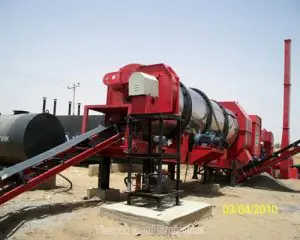Asphalt Drum Mixing Plant Manufacturer
Our Asphalt Drum Mixing Plant plays a vital part in the construction of sedulity, furnishing a reliable and effective system for producing high-quality asphalt mixtures. These plants are designed to meet the demanding conditions of road construction systems, icing the durability and life of the road shells they contribute to. Where they suffer a procedure of drying and heating. This ensures that the aggregates are free from moisture, allowing for better adhesion with the Asphalt Drum Mix Plant. A well-structured concrete mixing plant is vital for maintaining a clean and environmentally friendly operation. Modern asphalt barrel mixing shops are equipped with effective dust collection systems to minimize the release of particulate matter into the atmosphere. The continuous nature of the barrel mixing process not only boosts productivity but also contributes to cost savings. These shops are known for their energy effectiveness.

As the barrel’s rotating stir helps in maintaining a harmonious temperature, reducing energy consumption.With multitudinous drums set up for applicable warming of total and black-top; these shops are particularly effective in limiting warmth adversity for drag-out periods. We serve an immense demographic base by furnishing these shops with different reservations according to their exact musts. Also, we offer these shops in sealed speeding with the evidence of in-time deliverance. The asphalt mixers manufacturers process not only boosts productivity but also contributes to cost savings. These shops are known for their energy effectiveness, as the plant rotating stir helps in maintaining a harmonious temperature, reducing energy consumption.
- Longer administration life
- remarkable lumber cell-based advanced weighing
- Finishing working
- High sturdiness
- Simple to initiate
Essential Components and Specifications of Asphalt Drum Mix Plant
An asphalt drum mix plant is a continuous mixing system that produces the hot mixture asphalt required for different road construction projects. Unlike the batch mixing system, mixing works without interruption, which ensures a frequent supply of asphalt mixture.
A major component of an asphalt drum mix plant
Cold Aggregate Feeding System: It involves many compartments that store different sizes. Each bin material is equipped with adjustable gates to control the flow, ensure the accurate total ratio.
Single deck vibrating screen: removes screen and oversized agargeets, before they enter the drying drums, ensure uniformity in the final mixture.
Drying and mixing drums: a rotating drum where the sets dry up and then mixed with bitumen and filler materials. The first half of the drum is dedicated to dry, while the mixture occurs in the second half.
Bitumen storage and heating tanks: Store the required temperature and heat the bitumen before it is mixed with agargeets.
Mineral filling unit: Increasing asphalt properties, adds the required filler material to the mixture.
Fuel tank for the drum burner: supplies fuel to the burner, which heats the set in a drying drum.
Control room: A centralized system that manages and monitors the operation of the plant ensures accurate and efficiency.
Technical Specifications
While specific specifications may vary depending on the manufacturer and model, a standard asphalt drum mixes usually involve:
Capacity: 30 to 160 TPH (per hour ton).
Dryer Drum Size: Damping varies depending on capacity; For example, the size of the drum in the 40–60 TPH plant can be 1500 x 5500 mm.
Fuel tank capacity: About 10,000 to 30,000 liters depending on the size of the plant.
Bitumen storage capacity: typically between 15 and 35 tonnes.
Control system: Fully automated with PLC (Programable Logic Controller) for precise operations.
Pollution control: Equipped with wet dust collectors or baghouse filters to reduce environmental effects.
Application of asphalt drum mix plant
Asphalt drum mixes are versatile and are used in various applications, including:
Highways and Expressway Construction: Providing sustainable surface for heavy traffic.
Airport runways and taxis: smooth and safe landing and takeoff operations.
Urban and Rural Road Development: Connectivity and development of infrastructure.
Parking sites and industrial sites: offer strong surfaces for vehicles and equipment.

